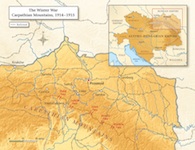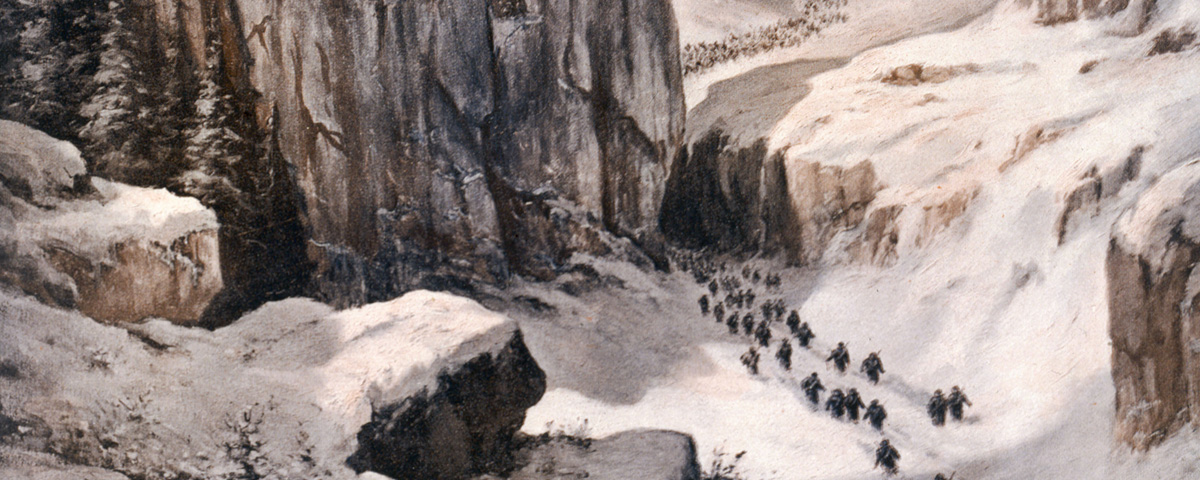Religious souls visualize hell as a blazing inferno with burning embers and intense heat. The soldiers fighting in the Carpathian Mountains that first winter of the war know otherwise.
—Colonel Georg Veith, Austro-Hungarian Third Army
DURING THE DEVASTATING OPENING MONTHS of World War I through the fall of 1914, the Habsburgs suffered numerous defeats against numerically superior Russian forces pushing into Galicia and the Carpathian foothills in the northeast corner of Austria-Hungary. In early November 1914, for the second time in as many months, the Russians had besieged the venerable Fortress Przemyśl, an enormous but obsolete 1854 stronghold on the San River that blocked the northern entrance to the Carpathians. The Russians bottled up the Austro-Hungarian garrison and utilized the region around it as a staging ground to control the vital routes into the heart of Habsburg territory. Their ultimate goal: to drive the Austro-Hungarians out of the war.
With some 130,000 troops under siege at Przemyśl and fearing a threatened invasion of Hungary, the Dual Monarchy simply had to take immediate steps to force the Russians from the Carpathian Mountains. In the winter of 1915, they launched three separate and equally ill-conceived offensives: an initial effort on January 23; a second uncoordinated assault on the Russians on February 27; and a third and final effort to liberate Fortress Przemyśl in late March.![]()
The geographical reality of the Carpathians would play a key role in the military catastrophe to come. The mountains along the contested front formed an arcing barrier roughly 60 to 75 miles wide with a median elevation of some 3,600 feet. In 1914–1915, only a handful of poorly constructed roads and a few railroad lines traversed the main passes in that area. Cold and damp, the mountains are often rainy in September and usually witness snowfall by November. They can remain covered in deep snow until spring, though sudden rises in temperature may also result in widespread flooding in the valleys.
Mountain warfare presents multiple difficulties for any major military action: Troops need to be specially trained, equipped, and accustomed to higher altitudes and challenging terrain and weather. The ability to maneuver and maintain a regular supply system in mountain conditions is problematic. Artillery logistics are especially challenging. Because it is difficult to transport and emplace artillery on uneven, elevated ground, many batteries are confined to lower terrain, an obvious disadvantage for attacking infantry. The Habsburg command had made no contingency plans for a mountain campaign lasting into the winter months—one of its many failures—because they accepted the “short war illusion.” It would prove to be a disastrous mistake.
Much of the blame for the calamitous winter campaign can be laid at the feet of the chief of the Austro-Hungarian General Staff, General Franz Conrad von Hötzendorf. Aside from needing to meet the obvious threat of invasion, Conrad also believed he had to win a major victory over the Russians to demonstrate the strength of the Central Powers. If the alliance among the Germans, Austro-Hungarians, Turks, and Bulgarians were perceived as weak, then such neutral European countries as Italy and Romania might enter the war on the side of the Triple Entente. Earlier, the Habsburg Supreme Command suffered a major embarrassment: the failure of Balkan offensives launched against Serbia in 1914. The most humiliating of these came in late November and early December at the Battle of Kolubara, when Habsburg forces captured the Serbian capital of Belgrade—only to lose it two weeks later. That reversal all but destroyed any remaining military prestige the Dual Monarchy possessed on the Balkan Peninsula.
Conrad saw in the Carpathian Mountains an opportunity to regain prestige with a swift military victory over the Russians and, like others in the Habsburg hierarchy, he feared the loss of Fortress Przemyśl would lead to defeat of the army and of the Dual Monarchy itself. So his main objective was to liberate the besieged stronghold. His grandiose plan, hatched in December, called for an offensive to be launched along a broad 100-mile forested front in the northern Carpathians by the Habsburg Third Army, even though it had not recovered from its costly October-to-December defeats. The newly created South Army, composed of three divisions from the German army and the rest—the majority—of Habsburg units, would simultaneously attack the Russians’ extreme left flank. Conrad believed his troops’ capabilities and the element of surprise were critical assets in his plan but that a bit of luck would be needed for the offensive to succeed.
On January 23, 1915, the first offensive began. Third Army consisted of 15 infantry and four and a half cavalry divisions supported by the neighboring South Army’s three infantry and two cavalry divisions. The combined offensive force of 175,000 men quickly proved inadequate to achieve the difficult mission assigned it, which was to secure the communication and rail centers in and around the towns of Medzilaborce, Lisko, Sanok, and Sambir.
The Habsburg forces did win some early minor victories, advancing into a 24-mile gap in the Russian lines. But that progress came against numerically inferior enemy units. By January 26, Third Army’s front extended 60 miles between the vital Dukla and Uzhok Passes. Despite that, the battle was already turning as the Russians began to launch massive counterattacks. A sudden, severe shift in the weather further undermined the Habsburg situation. The combination of weather-related and battle casualties rapidly depleted Habsburg frontline troop strength, reducing many divisions to only regiment or brigade size. By early February, the first Carpathian Mountain offensive had all but collapsed. The Russian forces continued to hold key passes in the region, including the strategic Dukla Pass. Following their successful counterattacks, Russian troops poured through the pass to threaten important railroad junctions. They soon outnumbered and stalled the Austro-Hungarian forces some 50 miles from Fortress Przemyśl, eliminating any chance of breaking the siege. By mid-February the Russians had effectively regained the initiative.
 COMBAT EXHAUSTION UNDER WINTER MOUNTAIN CONDITIONS is incomprehensible to anyone who has not suffered through such an experience. Habsburg troops routinely lacked basic necessities. Food supplies often did not reach the front at all, and when they did, they were usually frozen solid. Heavy rainfall, blinding snowstorms, and icy river crossings left the soldiers’ uniforms frozen to their bodies. The men lacked proper winter attire, and most suffered lung ailments and frostbite—many froze to death. What meager equipment the troops did receive proved unsuitable: Boots with cardboard soles, for example, quickly became unusable.
COMBAT EXHAUSTION UNDER WINTER MOUNTAIN CONDITIONS is incomprehensible to anyone who has not suffered through such an experience. Habsburg troops routinely lacked basic necessities. Food supplies often did not reach the front at all, and when they did, they were usually frozen solid. Heavy rainfall, blinding snowstorms, and icy river crossings left the soldiers’ uniforms frozen to their bodies. The men lacked proper winter attire, and most suffered lung ailments and frostbite—many froze to death. What meager equipment the troops did receive proved unsuitable: Boots with cardboard soles, for example, quickly became unusable.
The Habsburg Supreme Command displayed a profound ignorance of these obvious conditions throughout the war—an utter failure to recognize the realities of mountain warfare in winter. Many troops were deployed on open terrain with no cover and in subzero temperatures for extended periods, leaving many vulnerable to frostbite. Soldiers struggled to stay awake to avoid freezing. In snow that was often three to six feet deep, movement was especially difficult and exhausting. The troops had to dig out in order to go on patrol, launch an assault, clear defensive positions and the limited roads and trails essential for the movement of supplies. The shoveling required hours, sometimes days, and the burden of these tasks contributed to the physical and moral decline of Habsburg forces. Utterly exhausted, many of the troops became apathetic or committed suicide by shooting themselves or exposing themselves to enemy fire. Tens of thousands of horses, too—critical to the Habsburg supply chain—succumbed to overexertion and starvation.
Conditions were especially terrifying at night, with shrieking wind, impenetrable darkness, mysterious mountain sounds, and ice that could cake eyelids shut. Nighttime temperatures dropped to as low as -25°F, ensuring that many men left exposed to the elements would not survive until morning. Troops were frequently forced to march in the darkness for hours on end. They would sometimes see shadows swiftly traversing their positions into no man’s land and shortly thereafter hear screaming as wolves made a meal of wounded men.
The situation faced by frontline soldiers was exacerbated by the lack of reserves and reinforcements. The Dual Monarchy was the only major power that did not have a reserve army; it failed even to propose the creation of one until much too late. Hundreds of thousands of Habsburg soldiers were forced to occupy their positions until killed, wounded, captured, or listed as missing in action—meaning they had probably frozen to death. No relief was possible.
Total losses during the offensive exceeded 75 percent, most of them resulting from severe frostbite, exposure, or illness
Another fatal flaw of the first Carpathian Mountain offensive was the uncoordinated Austro-Hungarian attack efforts. Individual units would attack single enemy positions without communicating with their neighboring units. Even commanding officers ignored direct orders to launch a coordinated attack until it was too late to do any good. As the casualties mounted, Habsburg troops were too few to establish safe defensive positions along the rapidly extending front.
The Russians, on the other hand, regularly rehabilitated their frontline regiments, utilizing their shorter and more conveniently located road and railroad connections in the lower mountains. This advantage ended once they advanced farther into the mountains, but it did allow the Russians to launch powerful attacks against the ridgelines on the far side of the Carpathian Mountain range as late as April 1915.
Not only were Russian soldiers more accustomed to the climate and terrain, they were tactically superior and better led. They consistently waited for a pause in Habsburg offensive operations to unleash their own swift and powerful counterattacks. Night assaults were a favorite tactic of Russian commanders, who were also masters at retrograde movement, retreating from a position at the very last moment and reestablishing themselves, forcing the attacking Habsburg troops to remain in battle formation in the freezing weather. While the Habsburg troops struggled to advance over the rugged mountain terrain, the Russians more often occupied elevated positions. These advantages, along with superior artillery, enabled the Russians to transfer reinforcements quickly and deploy them against the rapidly declining Austro-Hungarian forces.
HABSBURG THIRD ARMY SUFFERED IMMENSE LOSSES during the first Carpathian offensive. Two weeks after it began, official sources listed 88,900 men as casualties. Their total losses during the offensive exceeded 75 percent, most of them resulting from severe frostbite, exposure, or illness. The Third Army commander, Svetozar Boroević, rightfully claimed that his army had not been prepared for the demands of a mountain winter campaign.
General Conrad had little patience for such rationales of defeat. Dissatisfied with the Third Army performance, he transferred the more pliable General Eduard von Böhm-Ermolli from the German front to the Carpathian Mountain theater. A newly formed Second Army, initially consisting of 60,000 to 70,000 exhausted Third Army right-flank units, was to deploy between Third and South Army positions. A further six and a half infantry divisions would be transferred to the front to support the new Second Army offensive.
In the meantime and in preparation for the second offensive, Conrad had ordered the Habsburg VIII Corps to be transferred from the Balkan front to support the Third Army’s effort to push the Russians out of the critical Dukla and Uzhok Passes. Again, the rail and communication centers of Lisko, Sanok, and Sambir were the primary objectives of the offensive.
As the planned day of attack, February 25, approached, the combination of falling temperatures and the incessant movement of troops and supplies all but destroyed the few roadways leading toward the front. Draft animals and obsolete heavy wagons became bogged down in the mud. The shortage of military labor and sapper crews made it nearly impossible to keep the roads open. Moreover, disease was spreading through the ranks as hygiene deteriorated along with physical condition; again, frostbite and sickness claimed entire regiments, diminishing the already inferior Habsburg troop numbers. Nevertheless, the second Carpathian Mountain offensive, though slightly delayed, went forward in late February.
Second Army’s main offensive was launched along both sides of the strategic roads leading toward Fortress Przemyśl. The frontal assault aimed at some of the same fortified positions previously targeted by Third Army. This time, however, the offensive occurred along a much smaller, 12-mile front. A frontal attack was deemed essential in response to mounting pressure, both military and political, to liberate Fortress Przemyśl and its large trapped garrison—now running desperately short of supplies, including food.
Although reinforcements were in transit to the front as the offensive got under way, the army’s middle and left flank positions quickly buckled under relentless Russian counterattacks. The continued pressure from the enemy forced arriving Habsburg reinforcements to be inserted piecemeal into the battle to fill the widening gaps in the front lines. The poorly trained replacement troops, already outnumbered, found themselves hurled into battle as cannon fodder.
On March 1 Colonel Veith of the Third Army wrote: “Fog and heavy snow falls, we have lost all sense of direction; entire regiments are getting lost, resulting in catastrophic losses.” Habsburg archduke Joseph August, commander of VII Corps, reported that over two days his Hungarian Honvéd Division “suffered terrible losses; its effective force numbers less than 2,000…and tomorrow, despite the casualties, we have to attack again. My corps losses since 1 March: 12 officers, 1,121 men killed, 46 officers and 2,121 men wounded, 2 officers and 685 men missing. This is really terrible.” With the Second Army bled white, the second Carpathian offensive failed completely, leaving the Austro-Hungarian army 60 miles short of the besieged fortress.
STILL, CONRAD REFUSED TO GIVE UP. The Second Army’s V Corps, positioned closest to the fortress and somewhat reinforced, received orders for an impossible mission: to liberate Przemyśl between March 20 and 23. Meanwhile, the Habsburg forces remaining in the Carpathians had to defend against ongoing enemy onslaughts. On March 20 the Russians unleashed a series of mass assaults in rapid succession in an effort to hurl the Habsburg Second and Third Armies back over the mountain ridges.
The starving soldiers, who had been living off horse meat and bread fillers for months, attempted a farcical but extremely bloody breakout
The day before that, on March 19, the starving soldiers at Przemyśl, who had been living off horse meat and bread fillers for months, had attempted a farcical but extremely bloody breakout. The futile gesture, allegedly undertaken to protect the “honor” of the Austro-Hungarian army, was ordered via coded telegram by General Conrad. It ended disastrously, and the garrison troops inside the besieged fortress at last surrendered. Later it became known that the Russians had broken the Austro-Hungarian code and thus knew of the planned fortress breakout attempt.
Incredibly, neither the Second Army Command nor V Corps was informed of the fortress surrender, so a few days later,
V Corps launched its completely pointless offensive. Having no chance of success, this third effort failed—with yet more enormous Habsburg casualties.
Fortress Przemyśl had come to symbolize Austro-Hungarian military prestige. Fearful of losing it to the enemy, General Conrad had allowed the fortress to distort his Eastern Front strategy to the point that the Habsburg army was almost annihilated by the end of the Carpathian Winter War campaign. Hundreds of thousands of men lost their lives, with scant gains to show for their sacrifice. Conrad’s flawed planning also resulted in the German military exerting greater control over the Habsburg command structure.
Yet the Russian strategy of driving through the Carpathian Mountains to deliver a deathblow to Austria-Hungary proved equally flawed. The campaign forced the Russians to deploy increasing numbers of troops into the inhospitable mountain terrain, drawing them ever deeper into a region that limited their mobility and dangerously overextended their already meager supply lines. When the Germans launched their successful Gorlice-Tarnów offensive in eastern Poland in May, the Russians were ill prepared, and that offensive gave the Central Powers their greatest victory of the entire war. It helped stabilize the Eastern Front while rescuing the Austro-Hungarian forces from annihilation.
Although the disastrous Carpathian Winter War has received scant attention over the past century, it was critically important to the First World War’s Eastern Front and foreshadowed the more famous “bloodbath” battles of 1916 at Verdun and the Somme. It stands as a lasting reminder of how unimaginably brutal conditions can transform a mountainous battlefield into a frozen hell.
Graydon A. Tunstall frequently writes about the Eastern Front in the Great War. His books include Blood on the Snow: The Carpathian Winter War of 1915 and The Austro-Hungarian Army in World War I.
Send us your comments! MHQeditor@HistoryNet.com






